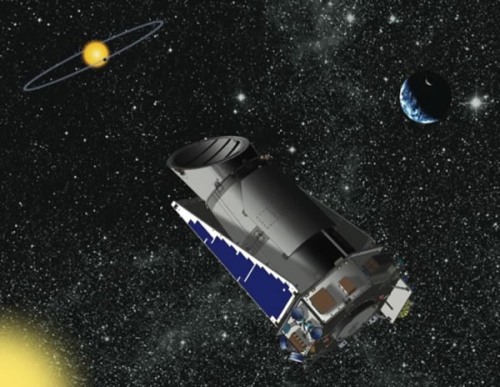
Retirement among the stars: Artist’s concept of the Kepler spacecraft. (Courtesy: NASA/JPL-Caltech/Ball)
By Tushna Commissariat
A few months ago, I wrote a blog about NASA’s Kepler space telescope being in a spot of trouble, as the spacecraft shut down and went into “safe mode”. The problem was that two of the four gyroscope-like “reaction wheels” that help the telescope remain steady and pointed in a particular direction had broken. Since May, researchers have been looking at ways and means to fix the problem or work around it.
Unfortunately, after analysing and testing the systems, the Kepler Space Telescope team has decided to end its attempts to restore the spacecraft to full working order, and is now “considering what new science research it can carry out in its current condition”.
In early August the mission’s engineers carried out “a system-level performance test” to evaluate Kepler’s current performance and found that the wheel that failed last year is now completely incapable of providing the precision pointing that they need to collect data. They therefore put Kepler back into its “sleep mode” – a stable configuration where it uses thrusters to control its pointing with minimal fuel use.
Thankfully, Kepler had already completed its primary mission objectives in November 2012 – and very successfully at that: Kepler has confirmed 135 exoplanets and identified more than 3500 candidates. It then started up its four-year extended mission, which has now been cut short.
But all is not lost just yet – for one, there is a huge amount of data from Kepler that is still waiting to be studied and analysed, which should keep astronomers and planet-hunters busy for quite a while. The Kepler team is also trying to think of other observations the telescope could still make (without the use of its wheels) that still centre on exoplanetary research. This will be through a two-pronged attack – an engineering study will determine what changes will be needed to run a “two-wheel” Kepler mission, while Kepler scientists are also looking to the exoplanetary studies community for ideas.
“At the beginning of our mission, no-one knew if Earth-sized planets were abundant in the galaxy. If they were rare, we might be alone,” says William Borucki, Kepler science principal investigator at NASA Ames Research Center in the US. “Now, at the completion of Kepler’s observations, the data holds the answer to the question that inspired the mission: Are earths in the habitable zone of stars like our Sun common or rare?”
Meanwhile, the second Kepler Science Conference will be taking place in November this year. It will provide an opportunity to share not only the investigations of the Kepler project team, but also those of the wider science community using publicly accessible data from Kepler.
Sad for the Kepler for losing its pointing capacity, but its current crop already confirms the unavoidable simple fact that in a univers with billions and billions of stars there must be millions and millions of exoplanets.